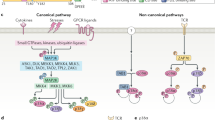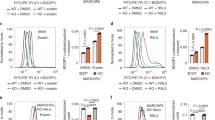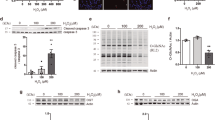Abstract
The c-Abl and Arg nonreceptor tyrosine kinases are activated in the response of cells to oxidative stress. The present studies demonstrate that treatment of cells with 0.1 mM H2O2 is associated with increased tyrosine phosphorylation of Arg and little effect on Arg levels. By contrast, exposure to 1.0 mM H2O2 decreased Arg phosphorylation. Treatment with 1.0 mM H2O2 was also associated with ubiquitination and degradation of Arg. The results show that Arg is stabilized in response to 0.1 mM H2O2 by autophosphorylation of Y-261, consistent with involvement of the Arg kinase function in regulating Arg levels. The results further demonstrate that c-Abl-mediated phosphorylation of Arg on Y-261 similarly confers Arg stabilization. In concert with these results, phosphorylation of Arg on Y-261 blocked H2O2-induced ubiquitination and thereby Arg degradation and inactivation. These findings demonstrate that Arg phosphorylation and degradation are differentially regulated by the degree of oxidative stress, and that Arg stability is conferred by phosphorylation of Y-261.
This is a preview of subscription content, access via your institution
Access options
Subscribe to this journal
Receive 50 print issues and online access
$259.00 per year
only $5.18 per issue
Buy this article
- Purchase on Springer Link
- Instant access to full article PDF
Prices may be subject to local taxes which are calculated during checkout






Similar content being viewed by others
References
Barila D and Superti-Furga G . (1998). Nat. Genet., 18, 280–282.
Berlett S and Stadtman E . (1997). J. Biol. Chem., 272, 20313–20316.
Brasher BB and Van Etten RA . (2000). J. Biol. Chem., 275, 35631–35637.
Cao C, Leng Y, Huang W, Liu X and Kufe D . (2003a). J. Biol. Chem., 278, 39609–39614.
Cao C, Leng Y and Kufe D . (2003b). J. Biol. Chem., 278, 29667–29675.
Cao C, Leng Y and Kufe D . (2003c). J. Biol. Chem., 278, 12961–12967.
Cao C, Ren X, Kharbanda S, Koleske AJ, Prasad K and Kufe D . (2001). J. Biol. Chem., 276, 11465–11468.
Croteau D and Bohr V . (1997). J. Biol. Chem., 272, 25409–25412.
Echarri A and Pendergast AM . (2001). Curr. Biol., 11, 1759–1765.
Fridovich I . (1997). J. Biol. Chem., 272, 18515–18517.
Goff SP, Gilboa E, Witte ON and Baltimore D . (1980). Cell, 22, 777–785.
Irani K, Xia Y, Zweier JL, Sollott SJ, Der CJ, Fearon ER, Sundaresan M, Finkel T and Goldschmidt-Clermont PJ . (1997). Science, 275, 1649–1652.
Ito Y, Pandey P, Mishra N, Kumar S, Narula N, Kharbanda S, Saxena S and Kufe D . (2001). Mol. Cell. Biol., 21, 6233–6242.
Jacobson MD . (1996). Trends Biochem. Sci., 21, 83–86.
Kharbanda S, Pandey P, Yamauchi T, Kumar S, Kaneki M, Kumar V, Bharti A, Yuan Z, Ghanem L, Rana A, Weichselbaum R, Johnson G and Kufe D . (2000). Mol. Cell. Biol., 20, 4979–4989.
Kharbanda S, Ren R, Pandey P, Shafman TD, Feller SM, Weichselbaum RR and Kufe DW . (1995). Nature, 376, 785–788.
Kipreos ET and Wang JYJ . (1992). Science, 256, 382–385.
Kruh GD, Perego R, Miki T and Aaronson SA . (1990). Proc. Natl. Acad. Sci. USA, 87, 5802–5806.
Kumar S, Bharti A, Mishra N, Kharbanda S, Saxena S and Kufe D . (2001). J. Biol. Chem., 276, 17281–17285.
Lewis JM, Baskaran R, Taagepesa S, Schwartz MA and Wang JYJ . (1996). Proc. Natl. Acad. Sci. USA, 93, 15174–15179.
Manna SK, Zhang HJ, Yan T, Oberley LW and Aggarwal BB . (1998). J. Biol. Chem., 273, 13245–13254.
Migliaccio E, Giorgio M, Mele S, Pelicci G, Reboldi P, Pandolfi PP, Lanfrancone L and Pelicci PG . (1999). Nature, 402, 309–313.
Nagar B, Hantschel O, Young MA, Scheffzek K, Veach D, Bornmann W, Clarkson B, Superti-Furga G and Kuriyan J . (2003). Cell, 112, 859–871.
Plattner R, Kadlec L, DeMali K, Kazlauskas A and Pendergast A . (1999). Genes Dev., 13, 2400–2411.
Pluk H, Dorey K and Superti-Furga G . (2002). Cell, 108, 247–259.
Sundaresan M, Yu Z-X, Ferrans V, Irani K and Finkel T . (1995). Science, 270, 296–299.
Sun X, Majumder P, Shioya H, Wu F, Kumar S, Weichselbaum R, Kharbanda S and Kufe D . (2000a). J. Biol. Chem., 275, 17237–17240.
Sun X, Wu F, Datta R, Kharbanda S and Kufe D . (2000b). J. Biol. Chem., 275, 7470–7473.
Tanis KQ, Veach D, Duewel HS, Bornmann WG and Koleske AJ . (2003). Mol. Cell. Biol., 23, 3884–3896.
Van Etten RA, Jackson PK, Baltimore D, Sanders MC, Matsuddaira PT and Janmey PA . (1994). J. Cell Biol., 124, 325–340.
Yin Y, Terauchi Y, Solomon G, Aizawa S, Rangarajan P, Yazaki Y, Kadowaki T and Barrett J . (1998). Nature, 391, 707–710.
Acknowledgements
This investigation was supported by Grants CA98628 and CA42802 awarded by the National Cancer Institute and Grant 30270316 from the National Science Foundation of China.
Author information
Authors and Affiliations
Corresponding author
Rights and permissions
About this article
Cite this article
Cao, C., Li, Y., Leng, Y. et al. Ubiquitination and degradation of the Arg tyrosine kinase is regulated by oxidative stress. Oncogene 24, 2433–2440 (2005). https://doi.org/10.1038/sj.onc.1208454
Received:
Revised:
Accepted:
Published:
Issue Date:
DOI: https://doi.org/10.1038/sj.onc.1208454
Keywords
This article is cited by
-
Abelson kinase’s intrinsically disordered region plays essential roles in protein function and protein stability
Cell Communication and Signaling (2021)
-
Molecular mechanisms of cardiotoxicity of tyrosine kinase inhibition
Nature Reviews Cancer (2007)
-
Arg
AfCS-Nature Molecule Pages (2006)
-
FOXO4 transcriptional activity is regulated by monoubiquitination and USP7/HAUSP
Nature Cell Biology (2006)



